Free Communication Skills Worksheets for Students (Pre-K–High School)
Get free social skills materials
No-prep lessons on self-regulation, emotional recognition, conversation skills, and more.
Sign up hereCommunication skills are central to how students learn, connect, and succeed at school. But they do not always come naturally. Many students need explicit support to express their thoughts clearly, understand others, and participate in group settings. That is why targeted instruction and repeated practice are so important.
In this article, you will learn what communication skills are, why they matter for student success, and how to teach them in ways that are practical and effective. You will also find a curated collection of free printable worksheets for students from pre-K through high school. These ready-to-use materials support skills like turn-taking, asking questions, staying on topic, and managing conversations with clarity and confidence.
Whether you are a classroom teacher, SLP, counselor, or intervention specialist, this guide offers concrete strategies and resources to help your students become more capable and confident communicators.
Ready-to-Use Tools for Communication and Conversation
Give students the tools they need to start, maintain, and grow peer interactions with free, ready-to-use printables and lessons.
What Are Communication Skills?
Communication skills are the tools students use to express themselves clearly, understand others, and navigate daily interactions across school settings. These skills go beyond vocabulary and sentence structure. They include both expressive and receptive language, nonverbal signals like eye contact and tone, and the ability to adjust communication based on the listener or situation.
Students use communication skills when they ask for help, follow directions, share an idea, join a group activity, or resolve a disagreement. Strong communication supports academic learning, classroom participation, peer relationships, and overall confidence.
For some students, these skills develop naturally. For others, especially those with speech-language challenges, autism, ADHD, or language processing difficulties, communication takes more practice. It is not just about what they say, but how they understand, interpret, and respond in real time.
Why Communication Skills Matter for Students
Communication touches every part of the school day. When students are able to share their thoughts, understand instructions, and collaborate with others, they are more confident, more connected, and more successful in both academics and relationships.
Students with strong communication skills are better able to:
- Ask for help or clarification
- Solve conflicts with peers
- Understand group norms and expectations
- Build friendships and classroom connections
- Participate in discussions, projects, and learning activities
When communication is difficult, students may seem off-task, quiet, frustrated, or disruptive. In many cases, these behaviors stem from a gap in communication, not from unwillingness. That is why these skills need to be taught clearly and practiced consistently.
Targeted communication skills instruction helps students become stronger listeners, clearer speakers, and more flexible thinkers. Whether the goal is turn-taking, asking for help, or perspective-taking, worksheets and structured activities give students the repetition and scaffolding they need to grow.
How to Teach Communication Skills
Teaching communication skills works best when it’s direct, consistent, and connected to real-life situations. Here are simple strategies you can use in any school-based setting:
- Use explicit instruction. Break down the skill into clear steps and explain what it looks and sounds like. For example, model how to ask for help or clarify a misunderstanding.
- Model real scenarios. Use think-alouds, role-play, or video examples to show how students can respond during conversations, group work, or moments of conflict.
- Provide visual supports. Sentence starters, communication scripts, and visual cues can give students a helpful reference point while they build fluency.
- Practice in low-pressure situations. Play-based activities, partner work, and guided discussions offer safe opportunities for students to try new skills without stress.
- Reflect and give feedback. After an interaction or activity, talk with students about what worked, what felt hard, and what they want to try next time.
Building communication skills takes time and repetition. When students are given a clear model, a chance to practice, and feedback that supports growth, they become more confident and more effective in how they express themselves and understand others.
Ready-to-Use Tools for Communication and Conversation
Give students the tools they need to start, maintain, and grow peer interactions with free, ready-to-use printables and lessons.
Free Communication Skills Worksheets for PK-12
These printable activities help students build real-world communication skills they can use in class discussions, group work, partner tasks, and daily interactions. From sharing ideas to asking questions and taking turns, each worksheet focuses on foundational skills that support clearer expression, better listening, and more confident participation.
Whether you’re working with preschoolers or high schoolers, these tools make it easier to teach communication with structure, visuals, and real-life application.
Sharing Play Ideas Worksheet (Pre-K & Kindergarten)
This activity helps students learn how to share a play idea with a classmate and agree on a plan. The cut-and-paste visuals reinforce the steps involved in initiating and collaborating.
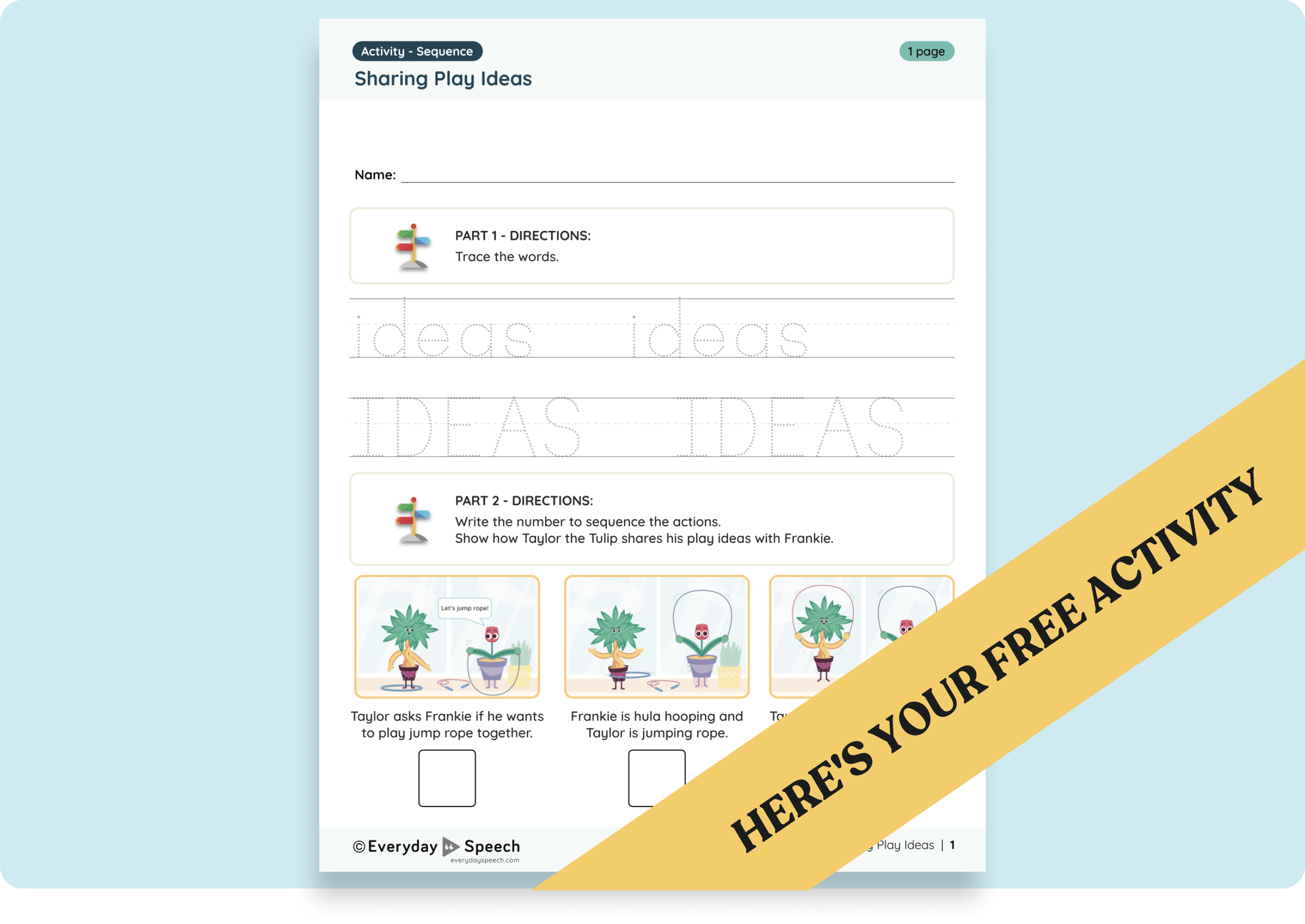
Instructional Tips:
- Teach sentence starters like “Let’s play ___ together” or “Do you want to ___?”
- Model a short interaction where two students take turns sharing ideas and agreeing on a plan
- Use puppets or toys to act out different play scenarios
- Post sentence frames or visuals near play areas to support continued use
WH-Question Finger Puppet Craft (Pre-K & Kindergarten)
This craft helps students understand common WH-questions through hands-on play. Each finger puppet corresponds with a question word, and students use them to answer prompts as part of a group game.

Instructional Tips:
- Introduce each WH-question one at a time, using examples and matching visuals
- Use the puppets to respond to questions like “Who has wings?” or “Where do bees live?”
- Allow students to take turns leading the game and asking questions
- Reinforce question forms during transitions and classroom routines throughout the day
Turn-and-Talk Snow Globe Craft (Pre-K & Kindergarten)
This winter-themed craft helps students learn how to take turns during conversations using the prompt “If I lived in a snow globe…”
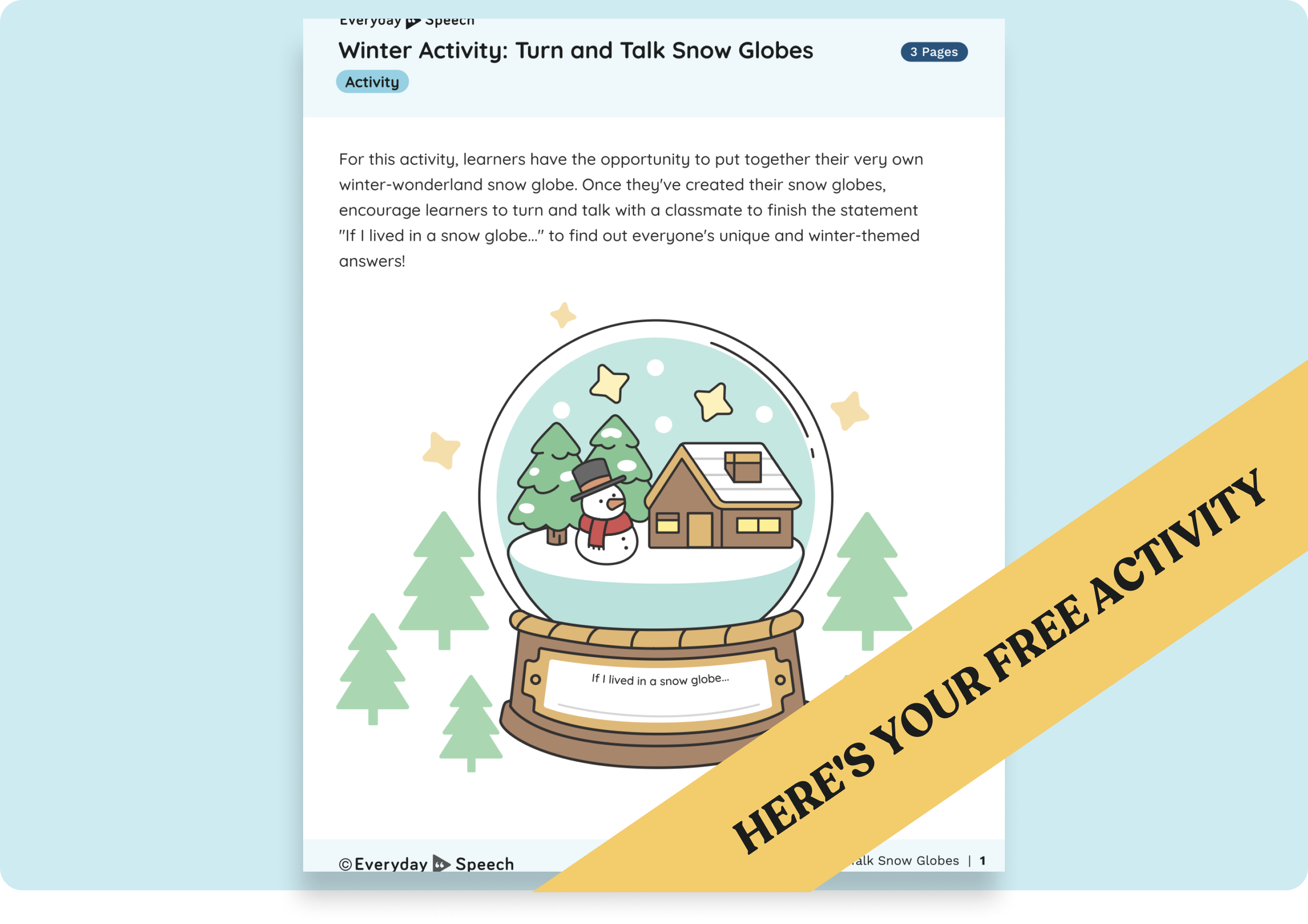
Instructional Tips:
- Start with a class discussion about what a conversation is and what it means to wait for your turn
- Model a short turn-and-talk interaction with a puppet or assistant
- Use a visual cue, such as a talking stick, to support turn-taking during partner sharing
- Praise behaviors like listening quietly, making eye contact, or asking a follow-up question
Connected Comments Activity (Elementary School)
This guided elementary communication skills activity teaches students how to respond with comments that stay on topic and add to the conversation. Includes sentence starters, role-play activities, and reflection prompts.
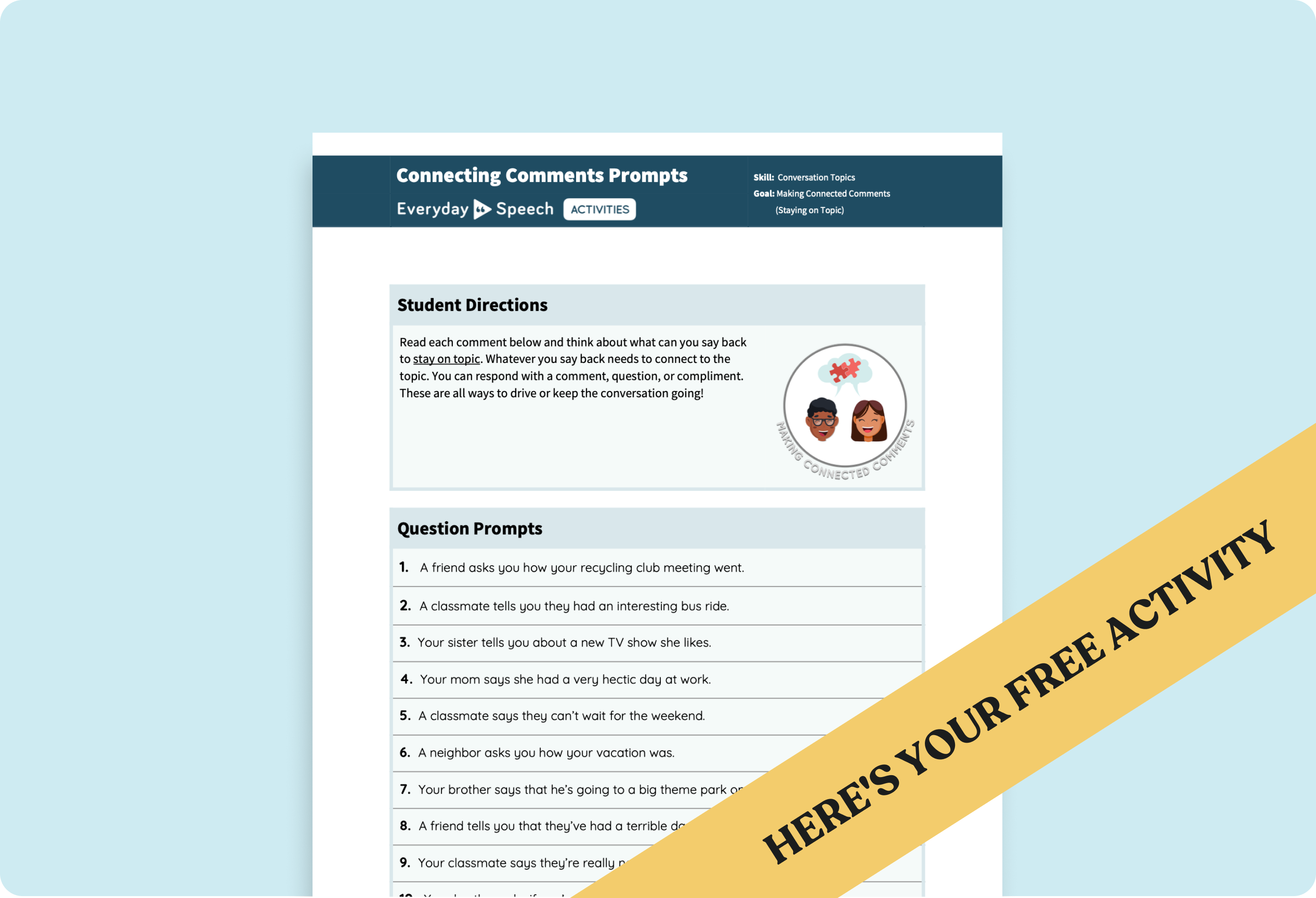
Instructional Tips:
- Model examples of strong and weak connections
- Use sentence stems like “That reminds me…” or “I agree because…”
- Role-play in pairs with teacher-led prompts
- Have students reflect on how their comment helped the conversation
Conversation Stoplight Practice Cards (Elementary School)
This conversation stoplight activity teaches students when to listen (red), pause and think (yellow), and take their turn to speak (green). Helps build awareness of timing and impulse control.
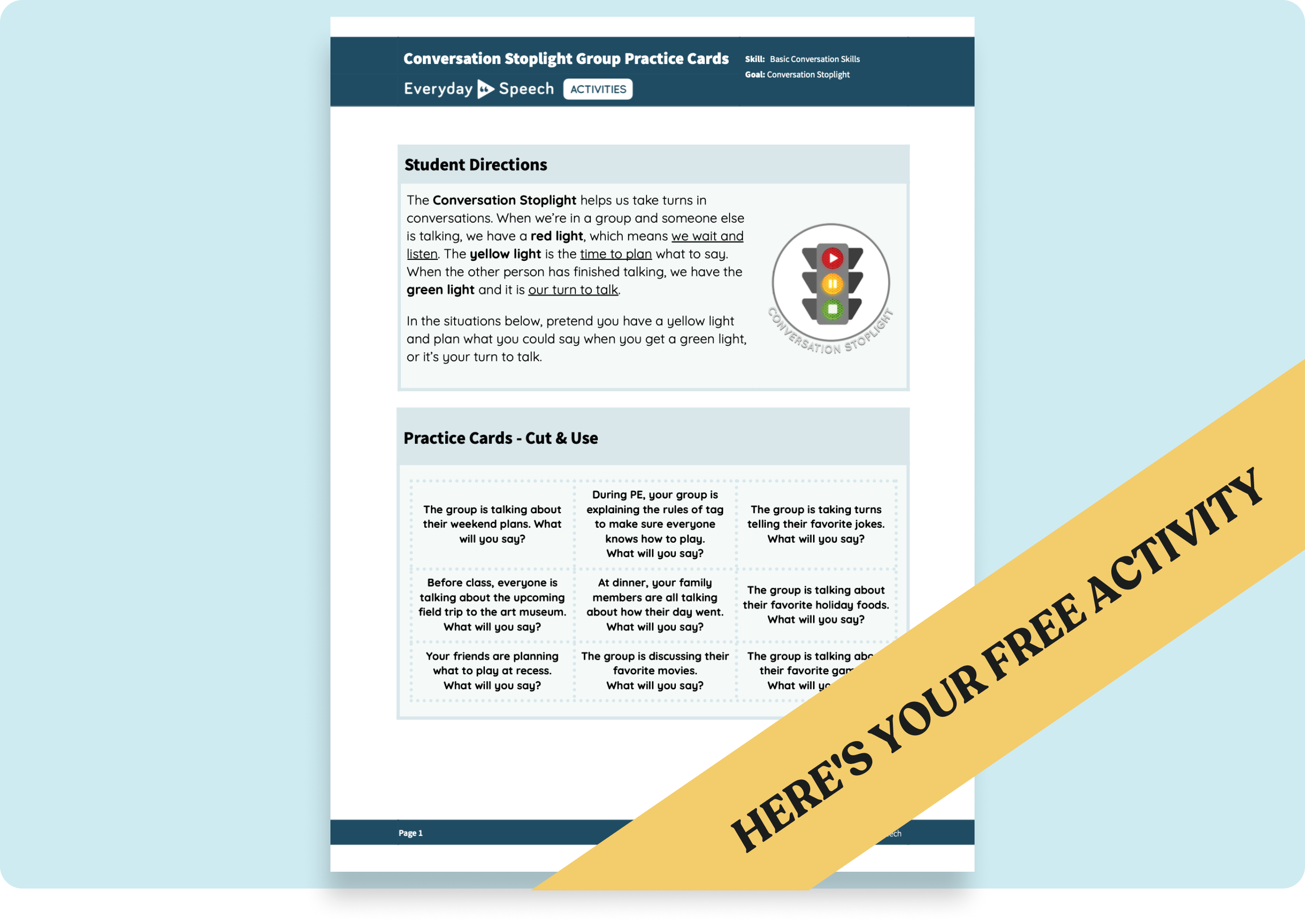
Instructional Tips:
- Introduce red/yellow/green behavior using classroom examples
- Use the cards in a small group or with a partner rotation
- Practice identifying each “light” in video or book discussions
- Post the visuals near discussion zones to cue behavior
Sharing a Conversation (Elementary School)

Instructional Tips:
This elementary sharing a conversation activity introduces five foundational skills: turn-taking, staying on topic, using body language, asking questions, and listening actively.
- Teach each skill one at a time with real examples
- Use cut-and-sort visuals to reinforce behavior
- Practice using all five skills in a role-play conversation
- Display the visuals as a reference during partner work
Recognizing When a Conversation is Over (Elementary School)
This lesson on knowing when a conversation is over teaches students to recognize when someone is wrapping up and how to respond.
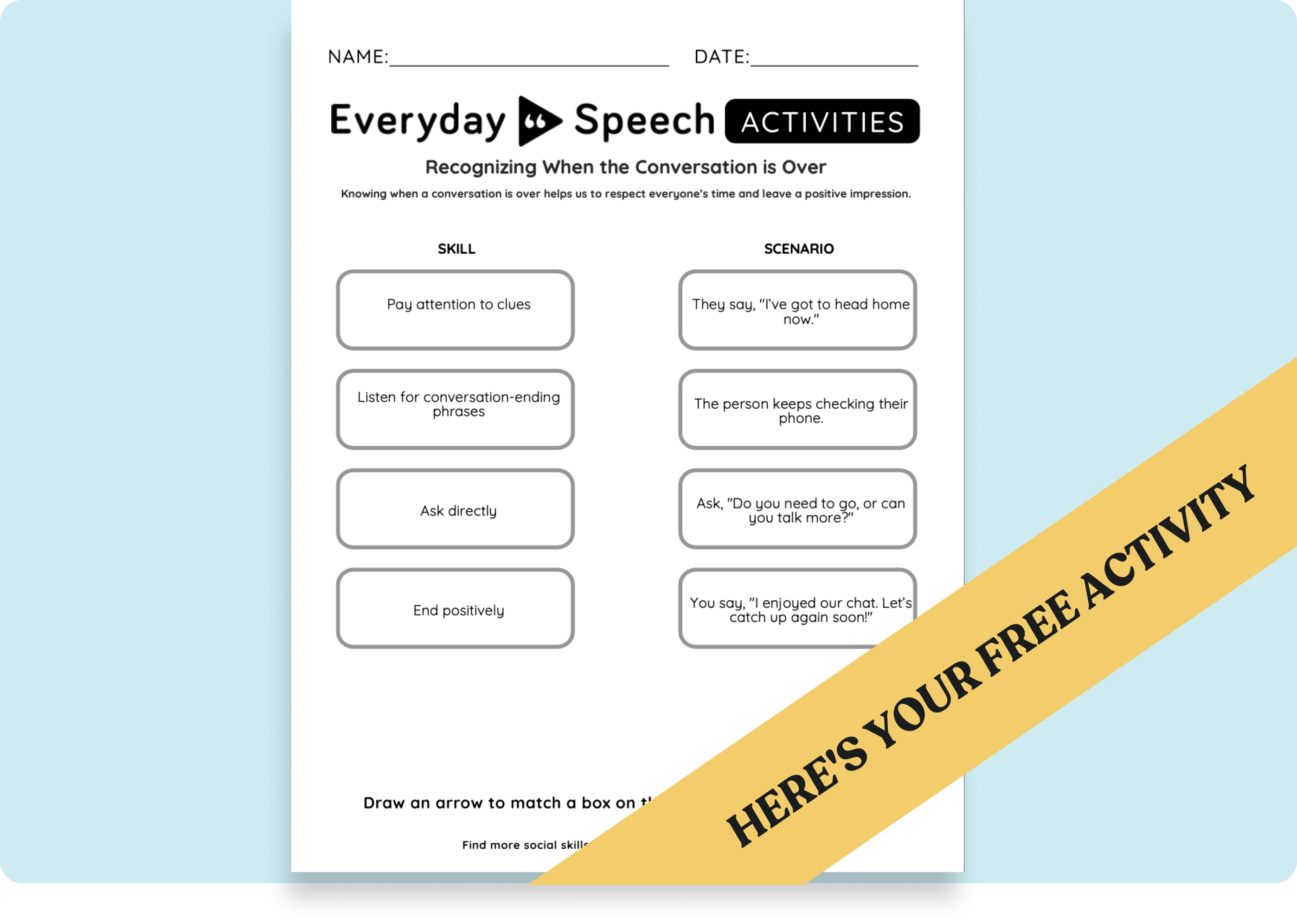
Instructional Tips:
- Teach four ending strategies: noticing cues, listening for phrases, asking directly, ending kindly
- Practice with worksheet and role-play scenarios
- Prompt students to observe peers during natural conversations
- Use exit slips to reflect on ending conversations during the day
Conversation Topics: What Should We Talk About? (Middle School)
This activity helps students choose appropriate conversation topics based on setting, audience, and shared interests. It encourages flexible thinking while providing clear structure. The conversation topics activity is a helpful tool for students who struggle to start or sustain peer interactions.
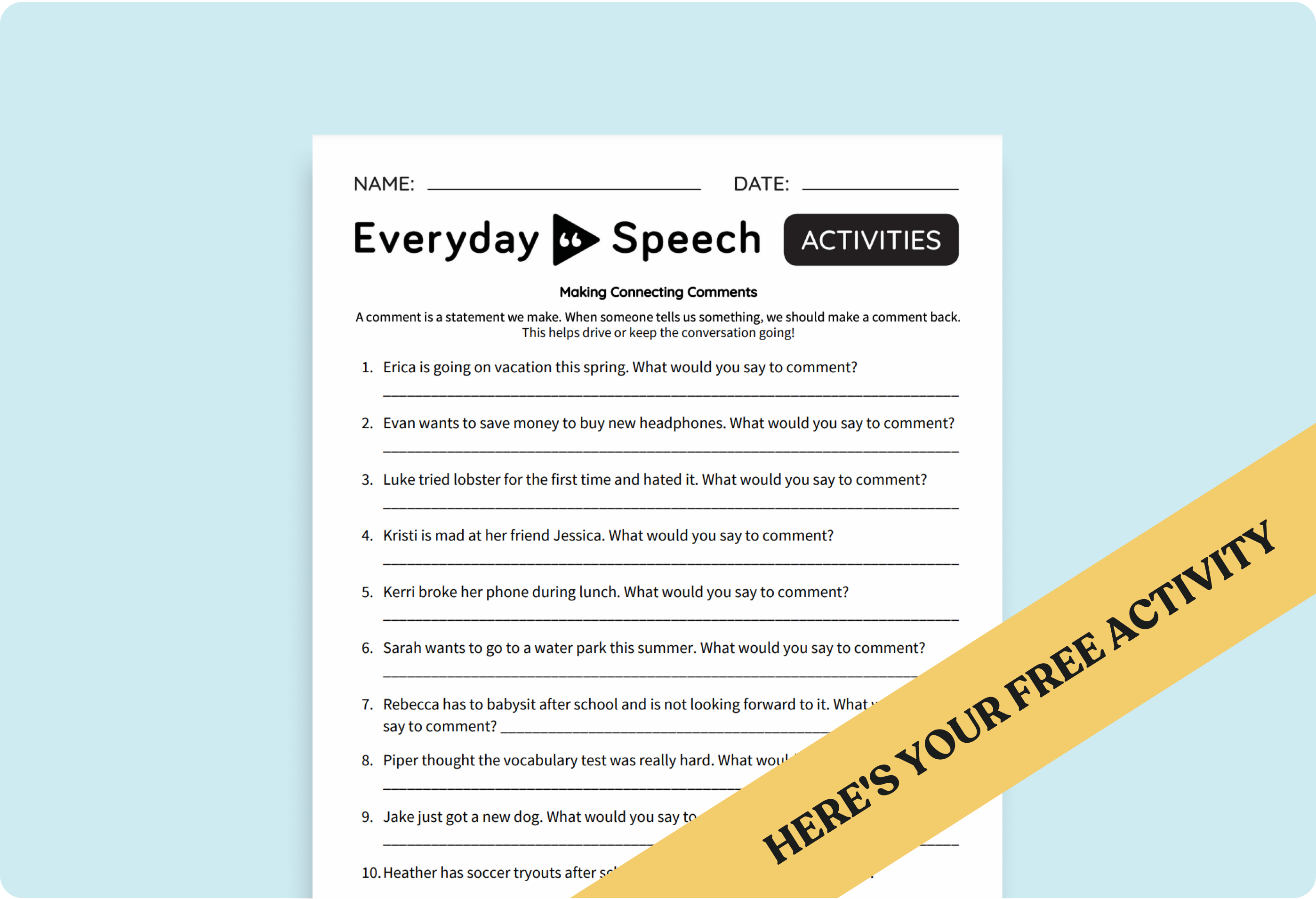
Instructional Tips:
- Use a sorting task to label topics as “great,” “maybe,” or “not now”
- Connect the activity to real classroom settings like lunch or advisory
- Encourage students to brainstorm new topics based on group interests
Maintaining a Conversation: Lesson and Visuals (Middle School)
This lesson breaks down how to keep a conversation going by asking questions, adding new ideas, and listening for cues. The Drive the Conversation lesson teaches students to stay engaged while building back-and-forth flow with peers.
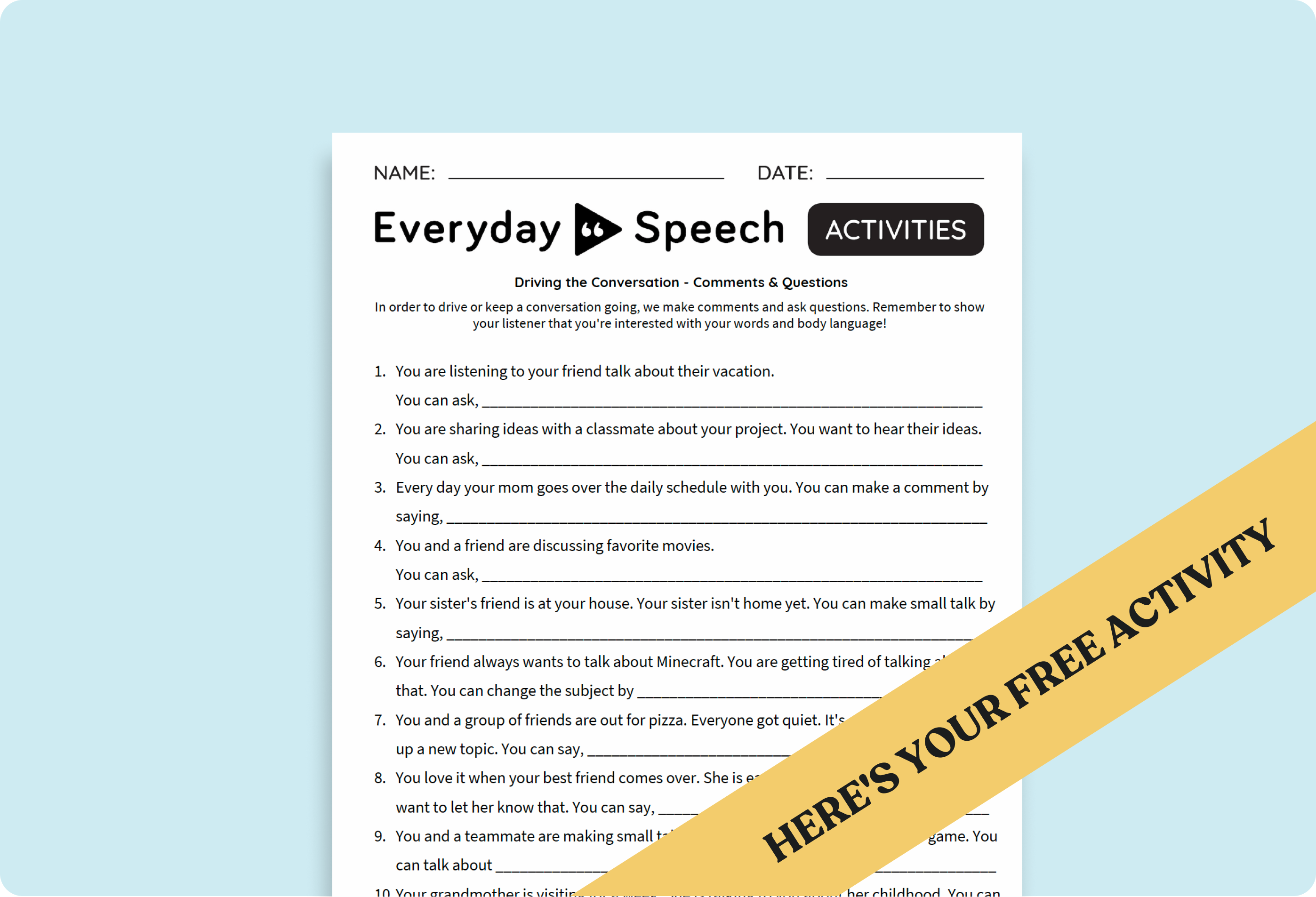
Instructional Tips:
- Use visual supports like a conversation map or flow chart
- Model “stalling out” vs. strong continuation techniques
- Prompt students to try Q-C-Q (question-comment-question) structures during practice
Knowing When to Talk: Lesson Plan (Middle School)
This activity teaches students how to read the room. They learn to recognize cues for when to speak, when to pause, and when to wait. The conversation stoplight lesson reinforces timing, turn-taking, and respect for others’ space in a group.
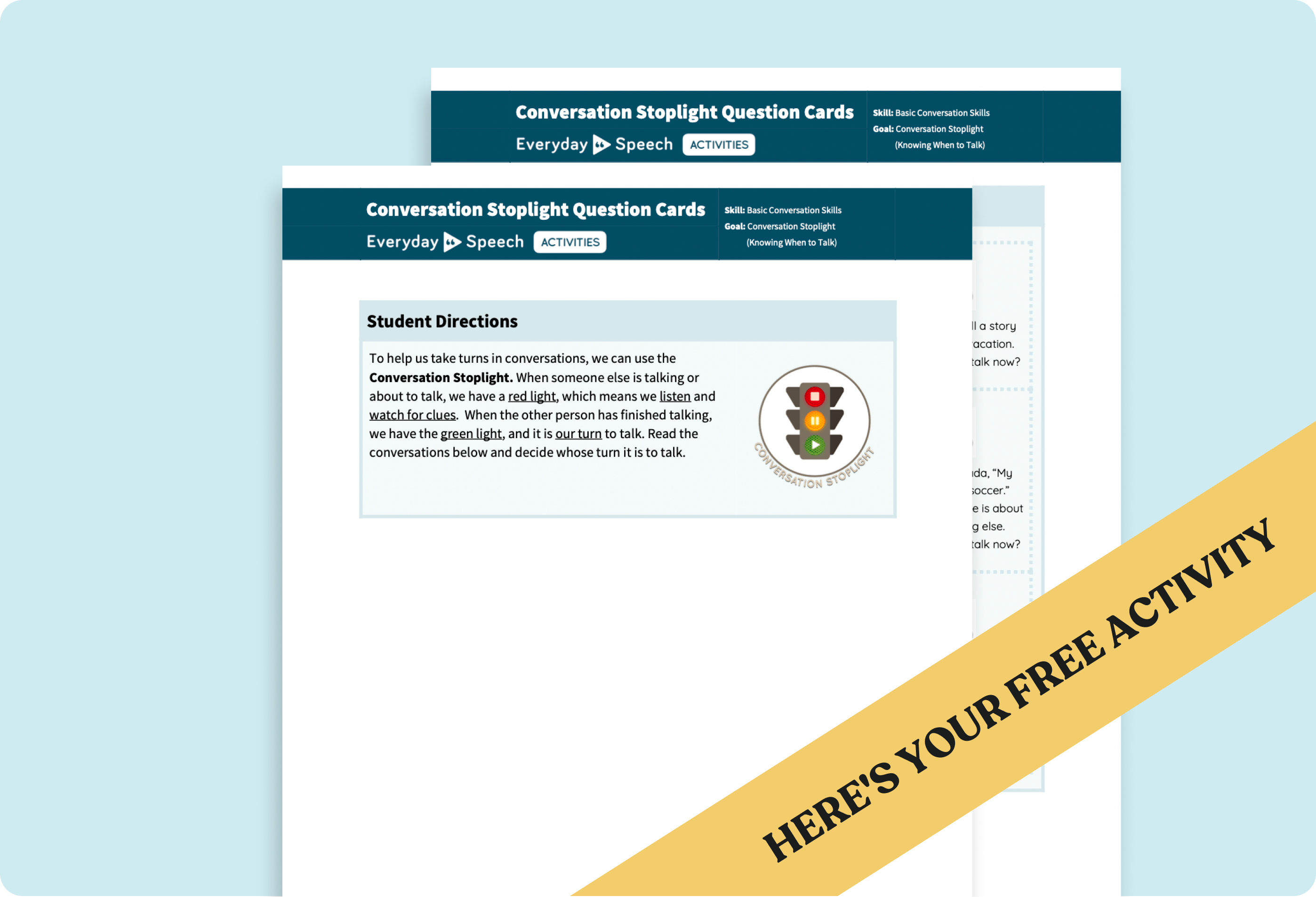
Instructional Tips:
- Practice labeling “go,” “slow,” and “stop” cues during videos or role-plays
- Use a visual stoplight system in classroom discussions
- Reflect after group work on moments when timing felt right or off
Conversation Cards (High School)
These printable cards give students structured prompts to start and extend conversations. Prompts cover everyday topics and support repeated practice in a variety of settings. The conversation cards for high school make a great warm-up tool for group work or advisory.
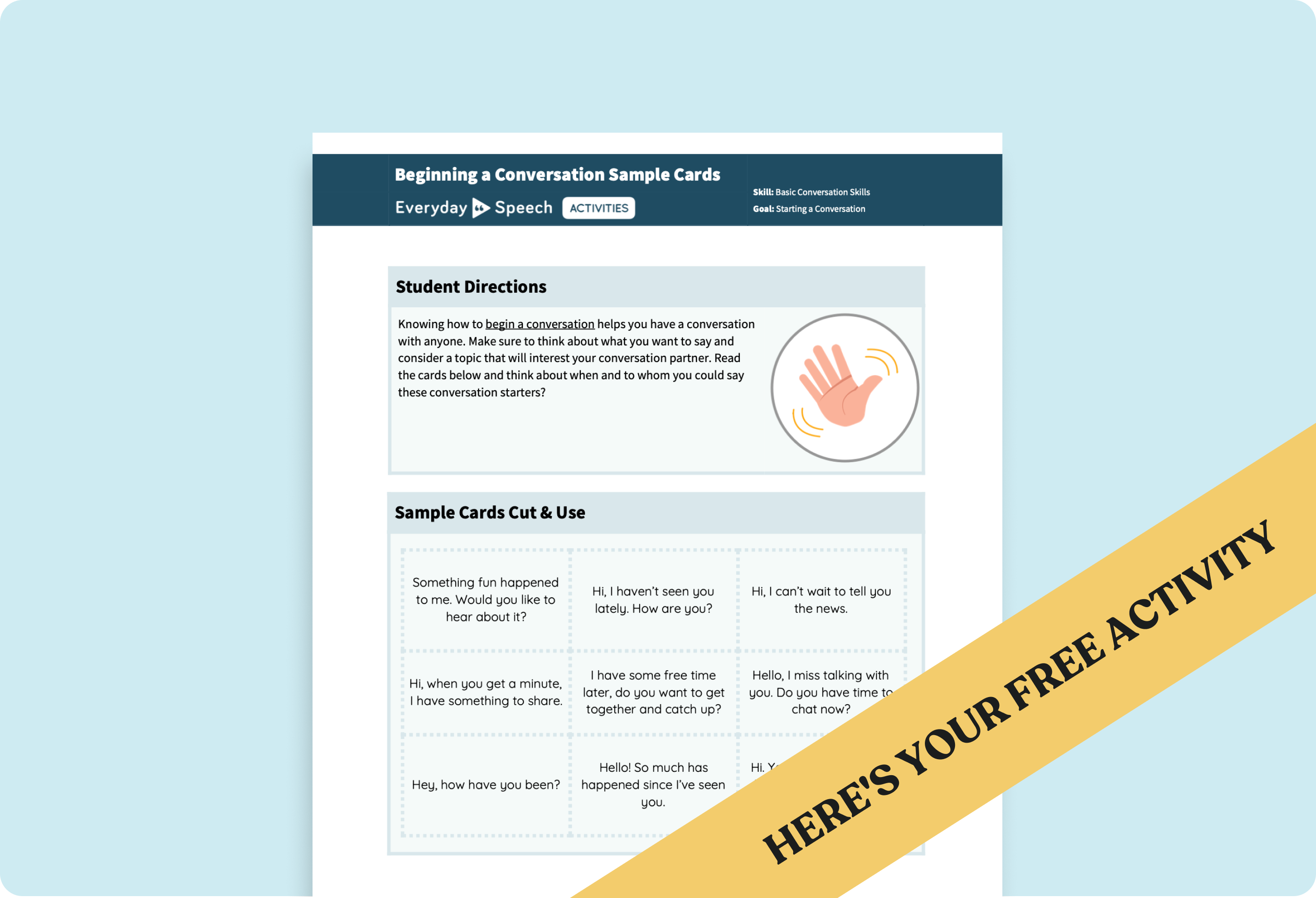
Instructional Tips:
- Use in warm-up rounds before group discussions
- Let students create new cards based on current events or personal interests
- Use as a reflection tool: Which card helped you learn something new?
Conversation GPS Packet (High School)
This packet uses a visual metaphor to help students plan and navigate a conversation “route.” It introduces topic transitions, follow-ups, and adjustments for different contexts. The conversation GPS packet reinforces connected thinking and smoother peer interactions.
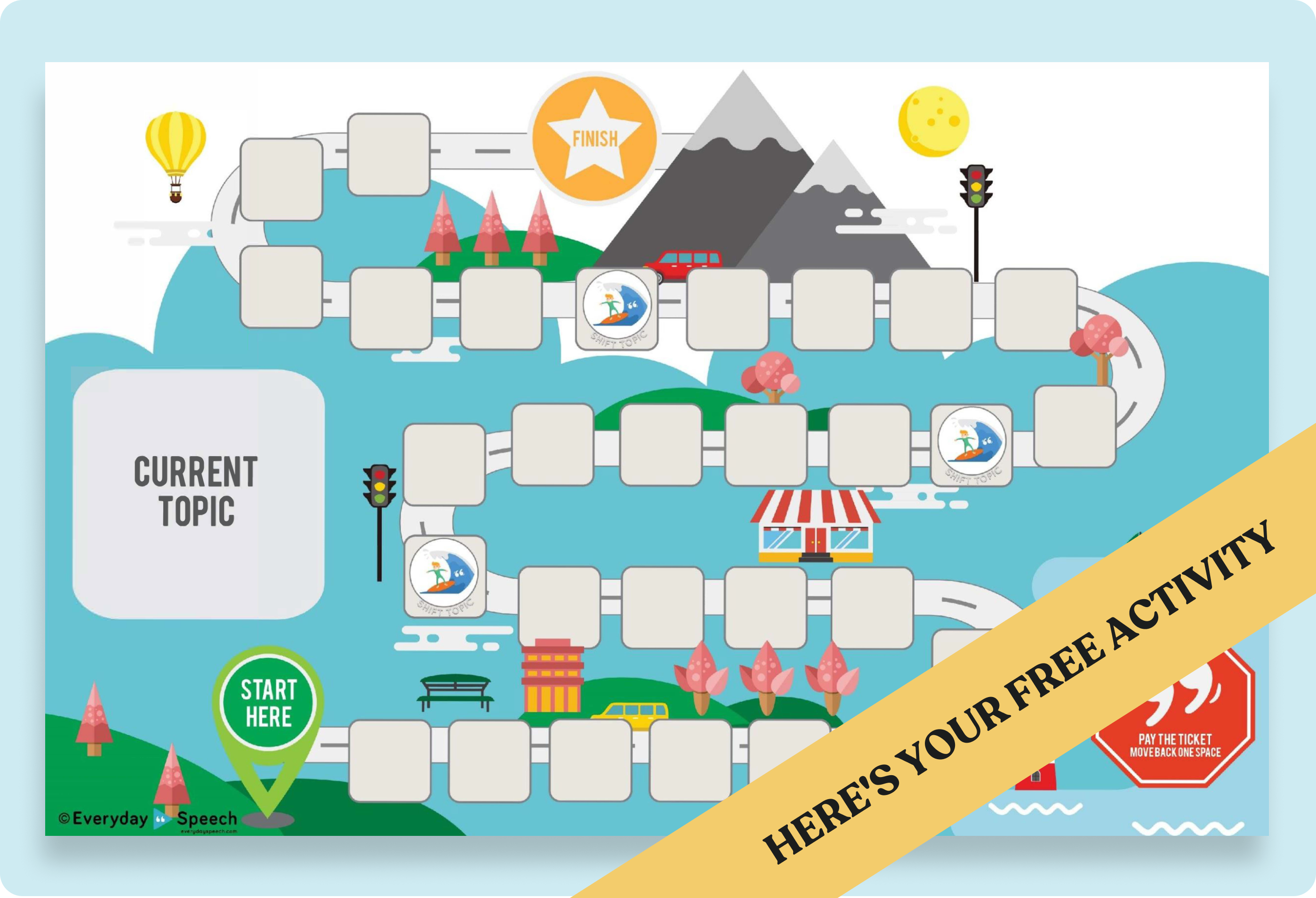
Instructional Tips:
- Use visuals to walk through a sample “route” of a conversation
- Let students draw their own GPS flowchart based on a peer exchange
- Reinforce during current events discussions or book talks
Understanding Conversation Share (High School)
This visual tool introduces the concept of balanced participation in conversations. Students reflect on how much space they take up and how to encourage turn-taking. The conversation share worksheet supports self-monitoring and more thoughtful peer exchanges.
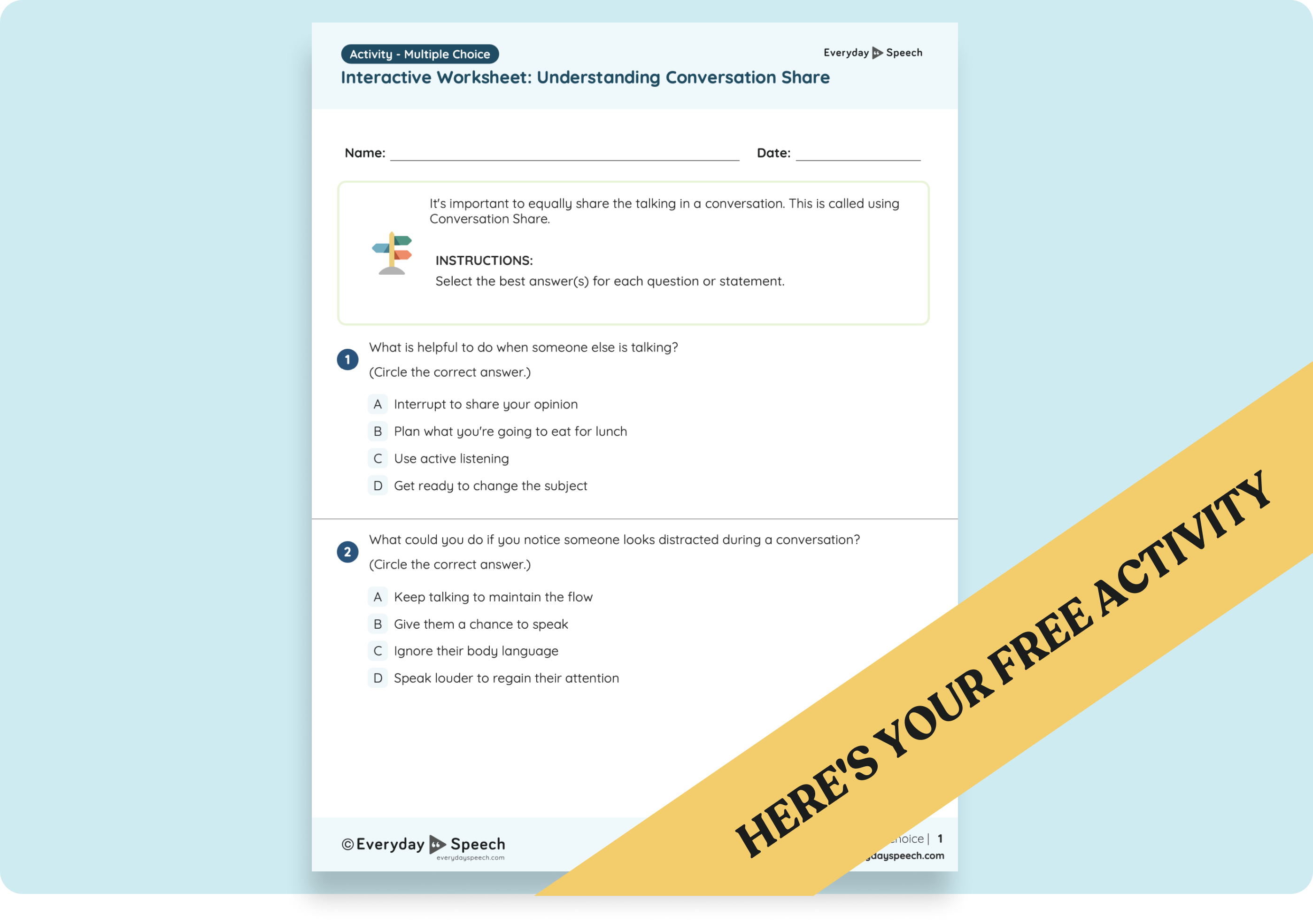
Instructional Tips:
- Use reflection prompts after group work: “How much did you talk?”
- Track participation using tallies or visuals
- Pair with self-monitoring checklists
Conversation Stoplight (High School)
This visual introduces a red-yellow-green system for thinking before speaking. Students learn how to pause, reflect, and respond appropriately in social settings. The conversation stoplight tool builds self-regulation and reduces impulsivity during group work or discussions.
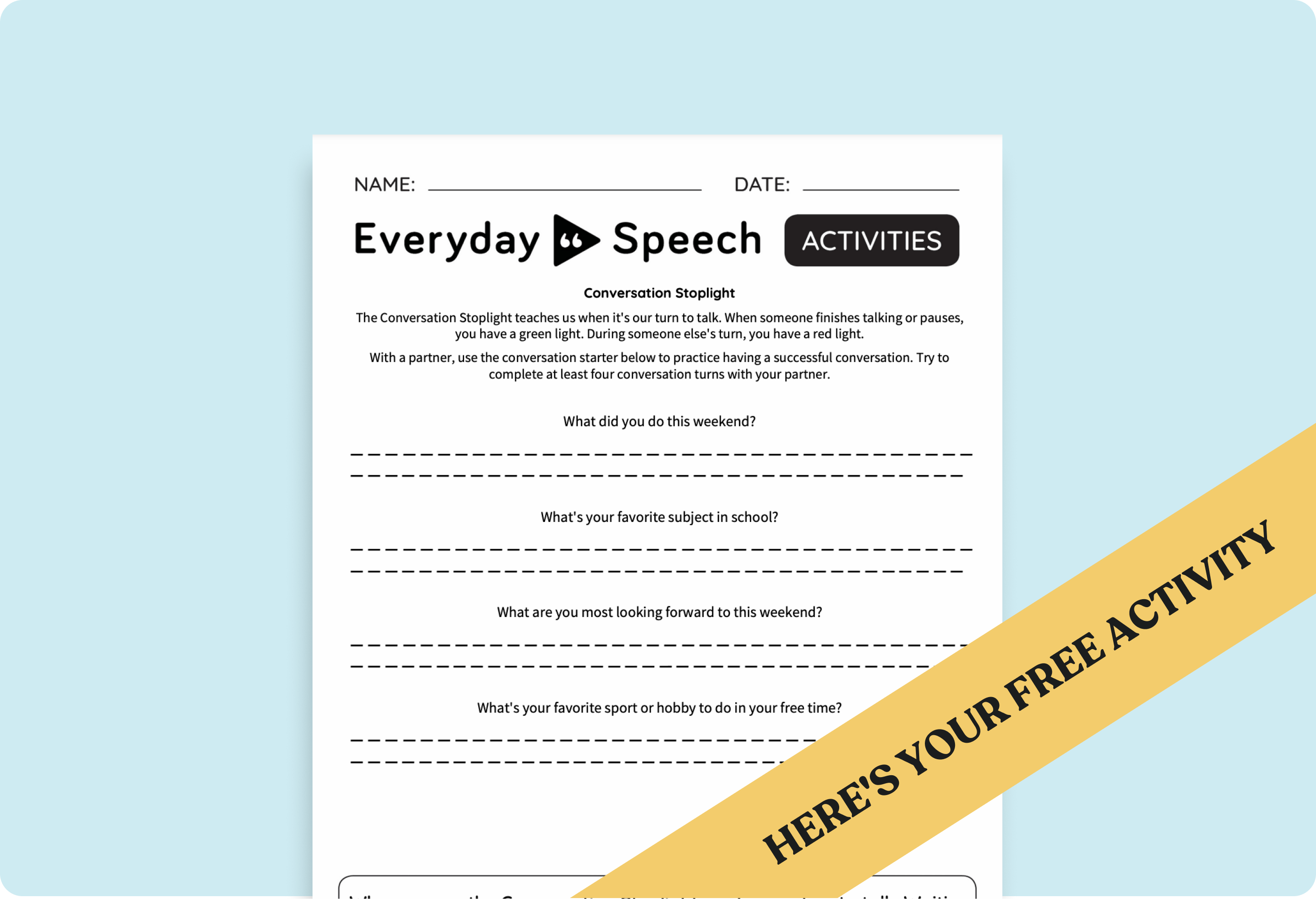
Instructional Tips:
- Practice with real scenarios: “When would you pause here?”
- Pair with social stories or reflection sheets after group work
- Use to prep for presentations or peer interviews
Ready-to-Use Tools for Communication and Conversation
Give students the tools they need to start, maintain, and grow peer interactions with free, ready-to-use printables and lessons.
Support Stronger Communication With Structured Practice
Helping students build communication skills is not a one-time lesson. It is an ongoing process that benefits from clear instruction, repeated practice, and supportive tools. Whether students are learning how to take turns, ask questions, join conversations, or adjust their tone, each interaction is a chance to grow.
The worksheets in this collection give students a structured way to explore, try, and reflect on real communication strategies. They make abstract skills more concrete and offer meaningful opportunities to practice in classroom or therapy settings. With the right support, students become not just better speakers and listeners, but more confident and connected learners overall.
Use these free worksheets to bring communication instruction to life and help every student find their voice.
Frequently Asked Questions About Teaching Communication Skills
1. What are the most important communication skills to teach in school?
Focus on foundational skills that support both academic and social success. These include turn-taking, active listening, staying on topic, asking and answering questions, using appropriate tone and volume, and adjusting language based on the setting or audience.
2. How do you teach communication skills to students with language delays or autism?
Use visual supports, sentence frames, and clear modeling. Break skills into small, teachable steps and provide repeated, structured opportunities to practice. Role-play and video modeling can also help reinforce new skills.
3. What are some signs a student may be struggling with communication?
Students who have difficulty with communication may interrupt often, avoid group work, misinterpret directions, speak off-topic, or rely heavily on adults to mediate peer interactions. Others may stay quiet even when they need help or want to participate.
4. How do communication skills impact learning and behavior?
Stronger communication leads to better academic engagement, fewer behavior challenges, and more positive peer relationships. When students can express themselves clearly and understand others, they are more likely to stay regulated, follow routines, and work independently.
5. Can communication skills be part of a student’s IEP?
Yes. Communication goals are often written into IEPs, especially for students receiving speech-language services or social-emotional support. Goals might focus on initiating conversations, using appropriate tone, asking for help, or following multi-step directions.
6. What’s the difference between communication skills and social skills?
Communication skills refer specifically to how students express and understand messages through words, gestures, tone, and listening. Social skills include a broader set of behaviors like sharing, joining in, showing empathy, and resolving conflict. The two often overlap but serve different instructional goals.
7. How often should communication skills be practiced?
Ideally, every day. Integrating practice into classroom routines, group work, and structured activities builds fluency. Short, frequent practice sessions are often more effective than isolated lessons.
